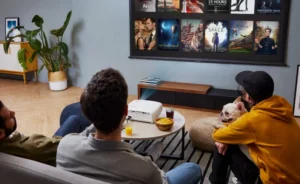How Back 4 Blood Is Leading The Horde

Introduction
Turtle Rock Studios, which was established in 2002 by Valve and Counter-Strike creators, got its start on Half-Life and Half-Life. The studio’s first original game Left 4 Dead, which was a zombie-shooter cooperative, is what made it famous. The project impressed Valve so much that in 2008 it bought Turtle Rock and published the game the following year. Left 4 Dead, a hit game for Valve and Turtle Rock was also a major success. They both helped to create the co-op shooting style and created a zombie explosion within gaming.
Following the studio’s split from Valve in 2009 (where Valve retained the Left 4 Dead IP), Turtle Rock began work on what would eventually become the asymmetric multiplayer shooter Evolve. Valve released a second Left 4 Dead, which was developed internally by Turtle Rock. Many other studios have attempted to replicate the same formula with varying degrees of success. Few were able to capture the original Left 4 Dead’s magic. The studio responsible for popularizing the genre has returned with a fresh effort. It not only continues the legacy of the most beloved game, but also expands on its formula.

The Rise of the Dead
The Dead Rise
Turtle Rock Studios’ post-Valve period saw the creation of asymmetric multiplayer modes in which a team of players pursues a powerful character. Evolve is a game where four hunters track a monster in a given environment. The monster then evades them until they are able to catch it. Evolve won rave reviews at expos and trailers. But, it was not without its flaws. Longer play sessions exposed the weaknesses in the system. It launched in 2015 to mixed reviews and a shrinking player base.
“In hindsight, when Evolve was playing correctly and when it was on, it was really, really great,” says studio co-founder and Back 4 Blood creative director Phil Robb. “But the problem was that it fell apart pretty easily whenever you had a teammate that wasn’t up to the task of fulfilling their role.”
Evolve’s servers were shut down in 2018. Turtle Rock fans had to wonder about the future. Thankfully, they didn’t have to wait long, as mere months after the closure of Evolve, in March 2019, the studio announced Back 4 Blood.
“We had some potential projects that we worked on here and there that never saw the light of day, which sort of happens a lot more than you’d like when you’re an independent developer,” Robb says. “We actually worked on a lot of cool s— during that time that we didn’t really ever get to show anybody, but at some point, somebody threw the opportunity out there and said, ‘Hey, how would you guys feel about getting back into the zombie space?’ Of course, we’re like, ‘Hell yeah!’ We love that genre, we like working in that space, and I feel like we’d been away from it long enough that we were anxious to get back in and start banging on that again.”

Clearly drawing inspiration from the Left 4 Dead name, Back 4 Blood has been considered by many a spiritual successor of the studio’s defining hit. Robb also recognizes it’s a bold choice but says the developer was setting itself up since it knew people would make comparisons regardless. But as he tells it, there’s more to Back 4 Blood’s name than just an homage to the studio’s previous games.
“There’s some other sort of poetic stuff in there if you think about it,” Robb says. “We had a bit of a rough time with our previous project, so we sort of felt like we’re back for blood. We were happy to be back in a genre and territory we loved being in back then and feel pretty comfortable in.”
Back 4 Blood’s basic concept is the same as Left 4 Dead: A team of survivors called Cleaners join forces to explore an infested area with Ridden zombies. They scrounge supplies and kill anything that gets in their way. On your journey, you will meet objectives and special enemies, as well as hordes upon zombies. That foundation will sound familiar to anyone who played Left 4 Dead, but the studio wasn’t content with simply replicating past successes. The team instead reexamined all aspects of the formula in order to find what was unique about the original.

Turtle Rock created a different cards system for each run to aid in this process. These cards contain the deeper modifiers. Each Cleaner offers some advantages, such as Holly giving more stamina and Evangelo giving everyone an additional speed boost. To bring a deck of cards with you into a session you must first make a list from your library. You then draw cards, and use different modifiers to your session.
Card systems like this have appeared in several games, but Turtle Rock didn’t want to shoehorn the mechanic in if it wasn’t the right fit. “I was even skeptical of it a little bit at first, but it’s totally grown on me,” Robb says. “I think at the end of the day when you play Left 4 Dead, you had a certain degree of agency in that you know you could go where you wanted, there was a number of weapons you could choose from, and then it was kind of just skill, and that was about it. With this, we introduced a lot more player agency, which I think is a welcome addition to the genre.”
You can get extra damage or health, reload faster, and more life during a session with these cards. You can even have them affect all your squad members, such as the one that I equipped to increase my team’s ammunition capacity. I was initially unsure about this system but I became more comfortable with it as I continued playing multiple missions of the same mission. In addition, since you can build your deck, it’s easier to complement your desired playstyle through cards meant for support, damage-dealing, scavenging, and more.

Running For Our Lives
Running For Our Lives
After a quick stop in Fort Hope (see sidebar) to gather my co-op partners, we jump into the opening campaign, The Devil’s Return. The mission is a series of challenging missions that requires us to blast our way through an industrial area, cross an overrun bridge and destroy a cruise vessel. But first we must choose our cards. A corruption card adds modifiers or bonuses to the match. This is our first Match in Back 4 Blood. I kept it simple. If we reach the saferoom before anyone else does, then we will get additional copper.
Each session begins with very little copper. This allows you to increase your initial loadout in the safe room. My copper is saved for next time so I opt for the automatic rifle that comes with the chair. Once we’re all geared up, we unlatch the lock and begin bashing and blasting.
In a deteriorating apartment block, the early stages of this stage are held. While the sorry state of the building is terrible news for those without renter’s insurance, the loot found in the rooms gives us plenty to pick up. This section is the best because I can grab some extra copper and medical supplies for when things turn sour. These apartments don’t have any zombies, but they are home to basic Ridden.

After completing our first task, we lower the bridge that allows us to travel from one rooftop onto another. After the sound attracts Ridden, we start fighting them off. The doorway to the opposite roof acts as an effective barrier, and my fellow teammates, who have spent their copper lofts for a Molotov cocktail on their rooftop, manages to eliminate a significant portion of our encroaching enemies. Maybe I shouldn’t have gone out and bought supplies.
When I reach the second saferoom I make a decision to use the available offerings. I have a decent amount of currency to spend, so I refill my rifle ammo and grab a grenade, but I’m eyeing the team support upgrade that gives all healing items extra effectiveness. I don’t have enough copper to purchase it this time, but I decide to scrounge in subsequent stages to give my team that handy upgrade.
Mid-point is reached when a Ridden about the same size as a building rises from the ground. Ogre enemies are a large, powerful boss who can either throw projectiles at you from far away or come up close to take your weapon. The Ogre escapes our first encounter, but it returns later to finish us off. Thankfully, we’re able to shoot its weak points enough to cause the massive beast to collapse.
While the Left 4 Dead inspiration is evident in nearly every facet of Back 4 Blood, Turtle Rock hasn’t completely thrown out the Evolve playbook. “I think you especially see those influences when you look at the Ogre,” says executive producer Lianne Papp. “We use a lot of those experiences from past titles to help develop that kind of experience and make it an awesome moment because I feel like it’s something you don’t really see in a zombie shooter: something that’s multiple stories tall and towering over you. It adds that extra element of, ‘Oh s—!’”
Though the Ogre serves as a definite highlight of the first campaign, it’s far from the finale. We reach a bridge with corroded beams that seems to be a barrier for survivors. You can see that few did.
There are many variants of the zombies found on this bridge. A Crusher, who stands at close to 15 feet tall, has an enormous arm which will crush you until you die unless there is a stun gun nearby or someone to help. The Hocker is an agile, tiny Ridden that stalks and traps you with a sticky substance. While those two may be the most frightening variants I have ever encountered, Reekers were always a pleasant sight to see. This zombie-type can vomit acid, inflict area-of-effect corrosive damage and some explode upon being killed, causing severe concussive injury to Cleaners nearby.

After an excruciating race across the bridge we reach the only thing that connects the Ridden infested to the survivor stronghold, a cruise boat. The only way we can break the link is to place explosives on the boat, and then blow it up. The explosions will begin counting down the second we put them in, making efficiency crucial. The ship’s activity has drawn a lot of Ridden making it difficult to get away in the time allowed. Our only surviving member of the team jumps off the edge and land on solid ground just before it explodes. Although the entire team was killed in the blast we consider it a success.
Once we have completed the first campaign, Blue Dog Hollow can be tackled, which will lead to a second group of missions. This campaign takes place in a more wooded area than the industrial park of The Devil’s Return. You will encounter zombie nests in farms, dark tunnels with Ridden and abandoned churches that you need to defend against undead waves. The campaign’s new horror, however, is the Sleeper. These terrifying creatures act as sendries for the wall. It jumps at anyone who is not paying attention and walks past it.
The Devil’s Return and Blue Dog Hollow demonstrate just how different the campaigns can be, leaving me hopeful that the rest of the PvE content will continue to deliver distinct twists on the formula Turtle Rock has established. For those who want a completely different experience, there is also competitive PvP online.
It’s Time to Change the Game
It’s Time to Change the Game
The cooperative campaigns seem to have the greatest content, but Back 4 Blood has a competitive PvP game mode. This competitive mode allows you to play on two sides in the zombie apocalypse. A team of four people controls the human Cleaners and the other can walk among the infected with powerful Ridden variations.
“I think it’s something a lot of people want,” Papp says. “You’re playing a zombie shooter, or you’re playing against monsters of some sort, and then inevitably there are people that go, ‘I want to be the monster. I want to be on the other side.’ It’s giving in to that kind of fantasy and providing people an opportunity to do that.”
Once they’ve selected their characters, they enter the scavenge phase. They can use the map to find weapons and other items before they are attacked by the Ridden. They must be ready for anything when the timer reaches zero.
You can become one of the Ridden special types that you see throughout the campaign, and transform your fear into joy. It’s empowering to act as a Crusher for a single survivor and put the pressure on them, but it is more rewarding to play as the Ridden with other players. We noticed Cleaners hunkering in closed-in buildings, on one map. So we selected Reekers and Exploders, with their explosive deaths and acid vomit. Once we had spawned we ran to the rooms, filled the acid with them, and ended the round quickly.

The Cleaners’ survival time determines how many rounds are played. After the Ridden take over Cleaners and kill all the team members, roles are reversed and zombie players become Cleaners in order to beat the time. Matches are played on a best of three basis. The hordes grow and shrink the more time passes.
Turtle Rock is excited for players to experience the co-op missions. “[We wanted to] have something that didn’t feel like a major time investment,” Papp says. “A term I’ve stolen from someone else in the industry is ‘snackable.’ I really love our PvP mode because you can just jump in, enjoy it for a little bit, your palms get sweaty, and then you can step back, drink a glass of water, take it easy, and then jump in again. You’re not committing yourself to a multi-hour experience.”
Get Ready To Feast
Get Ready To Feast
Many players have played Back 4 Blood in beta and alpha testing, but there is still much to discover about it. Turtle Rock Studios is certain that the game will appeal to those who are waiting for the Left 4 Dead sequel. We won’t know how much staying power Back 4 Blood has until after its launch, but the foundation is absolutely in place for players to have more fun than should be allowed in the apocalypse.
Back 4 Blood is available for download on PlayStation 5 Xbox Series X/S and PlayStation 4 Xbox One. Game Pass subscribers can download the game immediately and begin playing it.
Original publication: Issue 339, Game Informer.
#Blood #Leading#Horde








